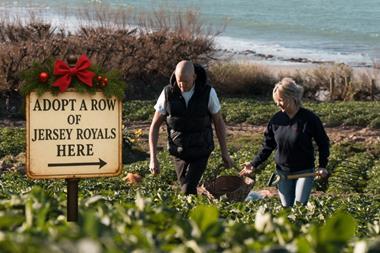While fears of CAP reform meltdown have faded, deep suspicion remains of retailers’ long-term intentions, says Vic Robertson
It has been billed as the biggest change to hit the farming industry in half a century but as the countdown progresses towards the introduction of the reformed Common Agricultural Policy in January, primary producers have become increasingly stoical. The feeling now is there will not be a meltdown in production of British milk, beef, lamb, grain, root crops or indeed any commodity - not in the early stages, at least, although in the longer term rationalisation is probable.
Much of this increased optimism is down to the team led by Sir Don Curry, whose report on the future of food and farming, which preceded CAP reform by some 18 months, crystallised much of the thinking the industry needed to build up links across the food chain and “reconnect” with the consumer.
This provided impetus to the development of the Red Meat Industry Forum and the Dairy Industry Group and the Food Chain Centre at the IGD. More recently, the industry has seen the creation of Dairy UK by producers and processors.
However, concerns remain. The key worry for farmers is that retailers will ignore the fact that subsidies have been decoupled from production and replaced by a single farm payment - and continue to drive down the price they are willing to pay suppliers or source more cheaply overseas. Large sectors of the beef and dairy sector complain that current prices do not cover their production costs. Duncan Sinclair, the MLC’s beef economist, predicts “evolution not revolution” in a market where production subsidies account for 40-55% of enterprise output. However, he adds: “This masks the fact that people are at different stages of technical expertise, but even those at the top will have to keep on the ball to bring production costs down further.”
Robert Forster, chief executive of the National Beef Association, takes a tougher line. Production subsidies were effectively consumer subsidies and with their removal production costs would have to be met in full by consumers and retailers. That would add £400 a head to the cost of a mature animal from the beef suckler herd. “We have talked with the multiples and found out how valuable they regard security of supply. But will they pay enough to ensure producers stay in the business after 2005?” he asks.
Chris Brown, Asda’s agricultural manager, does not expect much short-term change in beef or dairy supplies but agrees that in the longer term they must review the way the industry has adapted to the changes. “Farmers may have to ask themselves whether securing a market is an example of adding value,” he says.
Multiples have worked hard to set up supply chain links for beef and dairy. Paul Willgoss, head of agriculture with M& S, points to the success of its milk price contract in putting confidence and stability into the sector. “But we want to see some improvement in benchmarking leading on to more innovation. We also see the future for suckler beef production as quite positive. Any reduction in numbers will likely be over quite a long time,” he says.
Richard Cracknell, managing director of ABP, which has invested over £80m in plant in recent years, agrees. “We do not see UK farmers surrendering their hard-earned beef businesses to imports and we detect no enthusiasm among retailers to do other than strongly support home production. Supply and demand will decide prices.”
In spite of dramatic falls in price north of the Borders, there is optimism in the Scottish beef sector. However, James Withers, communications manager with the NFU Scotland, warns that “the rest of the supply chain needs to be acutely aware of the signals it sends producers from now on.
“It is a sad indictment that dairy farmers have been left with no option other than direct protest at supermarkets and processors.”
The upshot, says Robin Tapper, the NFU’s retail sector chief, who remains “bullish about beef”, will be painful rationalisation and consolidation in dairy. Nevertheless, he insists, for those in it for the long term, there is a future.
It has been billed as the biggest change to hit the farming industry in half a century but as the countdown progresses towards the introduction of the reformed Common Agricultural Policy in January, primary producers have become increasingly stoical. The feeling now is there will not be a meltdown in production of British milk, beef, lamb, grain, root crops or indeed any commodity - not in the early stages, at least, although in the longer term rationalisation is probable.
Much of this increased optimism is down to the team led by Sir Don Curry, whose report on the future of food and farming, which preceded CAP reform by some 18 months, crystallised much of the thinking the industry needed to build up links across the food chain and “reconnect” with the consumer.
This provided impetus to the development of the Red Meat Industry Forum and the Dairy Industry Group and the Food Chain Centre at the IGD. More recently, the industry has seen the creation of Dairy UK by producers and processors.
However, concerns remain. The key worry for farmers is that retailers will ignore the fact that subsidies have been decoupled from production and replaced by a single farm payment - and continue to drive down the price they are willing to pay suppliers or source more cheaply overseas. Large sectors of the beef and dairy sector complain that current prices do not cover their production costs. Duncan Sinclair, the MLC’s beef economist, predicts “evolution not revolution” in a market where production subsidies account for 40-55% of enterprise output. However, he adds: “This masks the fact that people are at different stages of technical expertise, but even those at the top will have to keep on the ball to bring production costs down further.”
Robert Forster, chief executive of the National Beef Association, takes a tougher line. Production subsidies were effectively consumer subsidies and with their removal production costs would have to be met in full by consumers and retailers. That would add £400 a head to the cost of a mature animal from the beef suckler herd. “We have talked with the multiples and found out how valuable they regard security of supply. But will they pay enough to ensure producers stay in the business after 2005?” he asks.
Chris Brown, Asda’s agricultural manager, does not expect much short-term change in beef or dairy supplies but agrees that in the longer term they must review the way the industry has adapted to the changes. “Farmers may have to ask themselves whether securing a market is an example of adding value,” he says.
Multiples have worked hard to set up supply chain links for beef and dairy. Paul Willgoss, head of agriculture with M& S, points to the success of its milk price contract in putting confidence and stability into the sector. “But we want to see some improvement in benchmarking leading on to more innovation. We also see the future for suckler beef production as quite positive. Any reduction in numbers will likely be over quite a long time,” he says.
Richard Cracknell, managing director of ABP, which has invested over £80m in plant in recent years, agrees. “We do not see UK farmers surrendering their hard-earned beef businesses to imports and we detect no enthusiasm among retailers to do other than strongly support home production. Supply and demand will decide prices.”
In spite of dramatic falls in price north of the Borders, there is optimism in the Scottish beef sector. However, James Withers, communications manager with the NFU Scotland, warns that “the rest of the supply chain needs to be acutely aware of the signals it sends producers from now on.
“It is a sad indictment that dairy farmers have been left with no option other than direct protest at supermarkets and processors.”
The upshot, says Robin Tapper, the NFU’s retail sector chief, who remains “bullish about beef”, will be painful rationalisation and consolidation in dairy. Nevertheless, he insists, for those in it for the long term, there is a future.















No comments yet